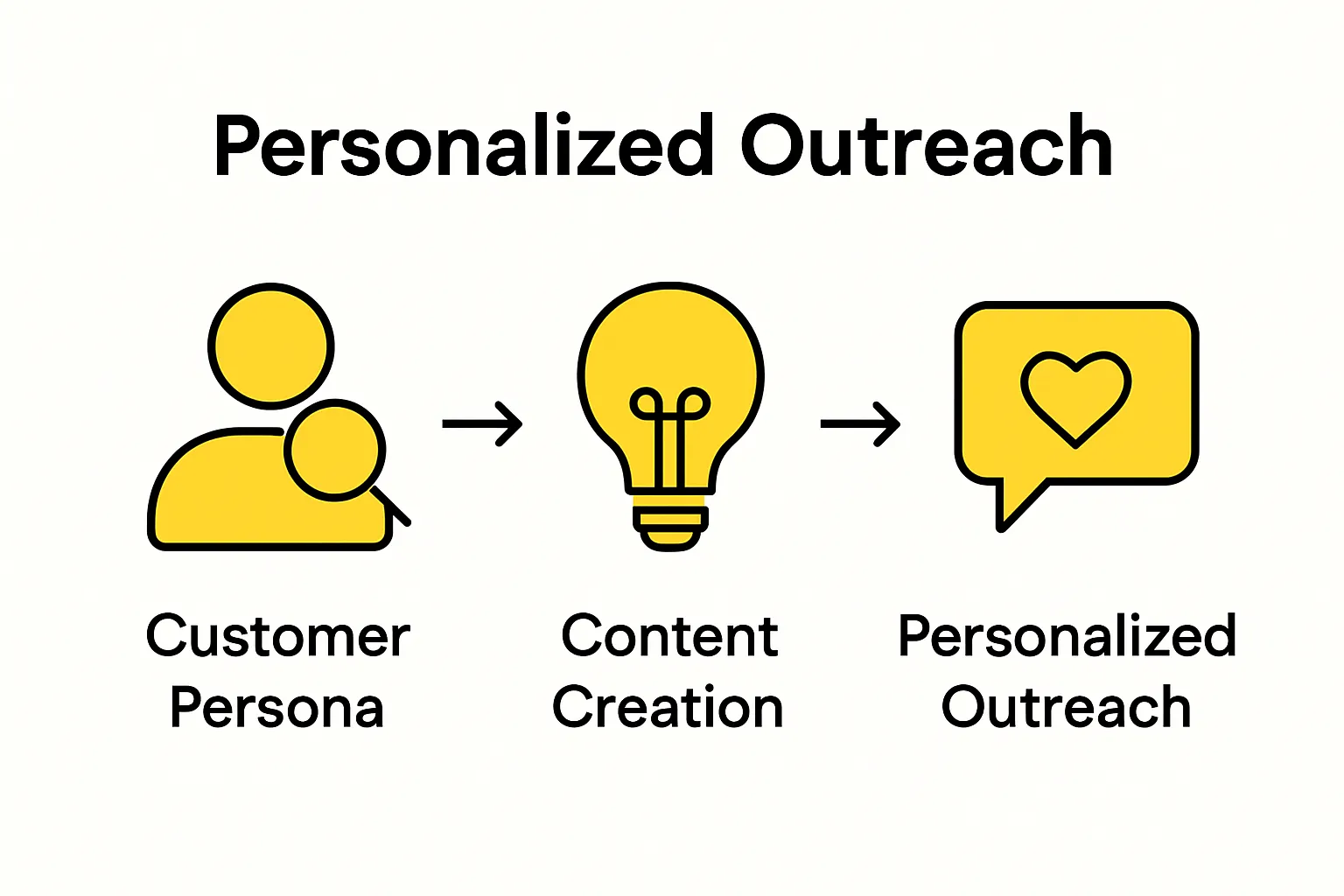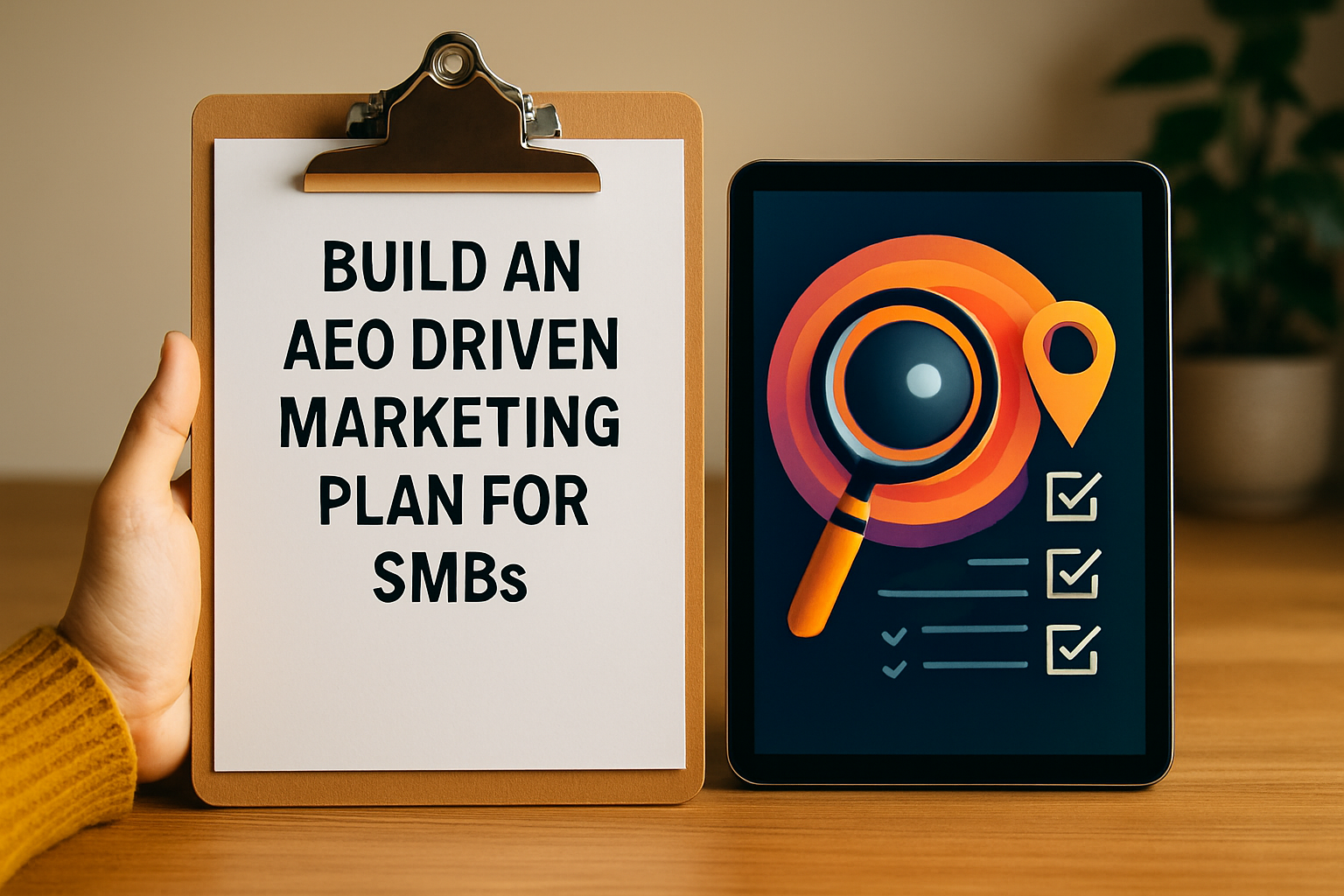Step-by-Step Lead Nurturing for Small Businesses

Small businesses often struggle to turn leads into loyal customers. Most just blast out generic emails and hope for the best. But companies that build detailed buyer personas and deliver targeted communication see a massive jump in results and some enjoy up to 171% higher marketing generated revenue. The real difference starts with understanding your audience at a level your competitors have never even considered.
Table of Contents
- Step 1: Define Your Target Audience And Buyer Personas
- Step 2: Create Valuable And Relevant Content For Engagement
- Step 3: Implement A Multi-Channel Communication Strategy
- Step 4: Track Engagement And Gathering Data For Insights
- Step 5: Optimize And Personalize Follow-Up Communications
Quick Summary
| Key Point | Explanation |
|---|---|
| 1. Define target audience and buyer personas | Understand your customers to tailor marketing effectively, transforming generic strategies into focused communications. |
| 2. Create valuable content for engagement | Develop content that addresses specific persona challenges, providing actionable insights without overt selling to build trust. |
| 3. Implement multi-channel communication strategy | Use various platforms to engage leads consistently, ensuring clear messaging aligns with preferences for better connections. |
| 4. Track engagement and gather data insights | Utilize analytics tools to measure engagement, identifying what drives interaction and optimizing future strategies accordingly. |
| 5. Optimize and personalize follow-up communications | Tailor follow-ups based on lead behavior and interests, creating a personalized journey that enhances engagement and relationships. |
Step 1: Define Your Target Audience and Buyer Personas
Defining your target audience and buyer personas is the foundational first step in an effective lead nurturing strategy. This critical process helps small businesses transform generic marketing approaches into precision targeted communication that resonates deeply with potential customers. Without a clear understanding of who you are trying to reach, your lead nurturing efforts will lack focus and effectiveness.
To begin crafting your buyer personas, start by analyzing your existing customer base. Review your current client records and identify common characteristics such as demographics, professional roles, industry sectors, and specific challenges they faced before engaging with your business. These insights provide a starting point for creating detailed representations of your ideal customers.
Gather comprehensive data through multiple channels. Conduct customer interviews, review website analytics, examine social media interactions, and analyze sales conversation records. Look for patterns in age ranges, income levels, professional backgrounds, and pain points. Create a narrative around each persona that goes beyond basic statistics. Each persona should feel like a real person with specific motivations, goals, and obstacles preventing them from solving their core problems.
A robust buyer persona typically includes key elements like professional title, age range, primary business challenges, communication preferences, and decision making criteria. For service based businesses, consider including details about their typical work environment, technology comfort level, and primary professional goals. The more nuanced and specific your personas, the more effectively you can customize your lead nurturing communications.
Verification for this step involves creating 2-3 distinct personas that represent your most common customer archetypes. Ask yourself these critical questions to validate your personas:
Below is a checklist to verify your buyer personas are effective and actionable for successful lead nurturing.
| Verification Criteria | What to Check |
|---|---|
| Represents real customers | Ensure personas are based on actual clients, not assumptions |
| Detailed challenges described | Personas clearly outline specific pain points and obstacles |
| Marketing materials align | Current content should speak directly to the defined personas |
- Do these personas represent actual customers or potential clients?
- Can you describe each persona’s specific challenges in detail?
- Would your current marketing materials speak directly to these personas?
By meticulously defining your target audience and developing comprehensive buyer personas, you establish a strategic foundation that will guide every subsequent step in your lead nurturing process. This initial investment of time and research transforms generic marketing into precision targeted communication that significantly increases engagement and conversion potential.

As HubSpot’s Marketing Research demonstrates, businesses with well defined buyer personas can achieve up to 171% higher marketing generated revenue compared to those with generic targeting strategies.
Step 2: Create Valuable and Relevant Content for Engagement
Creating valuable and relevant content is the cornerstone of successful lead nurturing for small businesses. This step transforms your understanding of buyer personas into strategic communication that attracts, educates, and ultimately converts potential customers. Your content must solve real problems, answer specific questions, and demonstrate your unique expertise in ways that build trust and credibility.
Start by mapping content directly to each buyer persona’s specific challenges and interests. For each persona, develop a content strategy that addresses their unique pain points at different stages of their buying journey. This means creating materials that speak to awareness, consideration, and decision making stages. Educational content works best when it provides actionable insights without overtly selling.
Consider diversifying your content formats to maximize engagement. Blog posts, video tutorials, downloadable guides, webinars, and email newsletters can all play crucial roles in nurturing leads. Short form content like social media posts can spark initial interest, while long form content like comprehensive guides can demonstrate deep expertise. Each piece should provide genuine value that helps your potential customers solve real business challenges.
Practical content creation requires a systematic approach.
Develop a content calendar that schedules regular publications across different platforms. This ensures consistent communication and helps you track which types of content generate the most engagement. Use analytics tools to monitor which pieces resonate most with your target audience, and continuously refine your approach based on these insights.
Verify your content strategy by checking these key indicators:
Use this checklist to confirm your content strategy is aligned with lead nurturing best practices for each buyer persona.
| Content Strategy Check | What to Look For |
|---|---|
| Addresses persona challenges | Content is mapped to specific pain points of each persona |
| Delivers actionable insights | Each piece helps the lead learn or solve a real problem |
| Valuable for the audience | Content is genuinely useful from the target audience’s perspective |
- Does each piece of content directly address a specific buyer persona’s challenge?
- Can a potential customer learn something actionable from your content?
- Would you find this content helpful if you were in the target audience?
As Content Marketing Institute Research demonstrates, businesses that prioritize audience focused content see significantly higher engagement and conversion rates. By investing time in creating truly valuable materials, you transform your lead nurturing from a transactional process into a relationship building strategy that positions your business as a trusted advisor.
Remember that content creation is an ongoing process of learning, adapting, and improving. What works today might need refinement tomorrow, so remain flexible and committed to understanding your audience’s evolving needs.
Step 3: Implement a Multi-Channel Communication Strategy
Implementing a multi-channel communication strategy transforms how small businesses engage with potential leads by meeting customers where they are most comfortable. This approach recognizes that different personas prefer different communication methods and that consistent messaging across multiple platforms builds trust and increases engagement potential.
Begin by selecting communication channels that align closely with your buyer personas. Email remains a powerful primary channel, but integrate social media platforms, SMS messaging, and targeted digital advertising to create a comprehensive approach. The key is not just using multiple channels, but ensuring your messaging remains consistent and personalized across each platform. This means developing a unified brand voice and message that feels familiar regardless of where a potential customer encounters your content.
Technological tools can significantly streamline multi-channel communication efforts. Customer relationship management (CRM) platforms enable tracking interactions across different channels, allowing you to understand how leads move through your communication ecosystem. Automation tools can help schedule and coordinate messages, ensuring timely and relevant communications without overwhelming your potential customers. Look for solutions that allow segmentation and personalization, enabling you to send targeted messages based on specific lead behaviors and interests.
Effective multi-channel strategies require careful attention to communication frequency and timing. Avoid bombarding leads with excessive messages that could trigger disengagement. Instead, develop a thoughtful cadence that provides value at each interaction. Some leads might appreciate weekly email newsletters, while others might prefer occasional text message updates or social media interactions. The goal is creating a communication rhythm that feels helpful and informative rather than intrusive.
Verify your multi-channel strategy by assessing these key indicators:
Review this checklist to ensure your multi-channel communication approach is consistent and meets the needs of your buyer personas.
| Communication Check | What to Assess |
|---|---|
| Consistent messaging | Unified brand voice across all platforms |
| Matches persona preferences | Chosen channels reflect target audience habits |
| Engagement tracked | Ability to monitor responses across platforms |
- Are messages consistent across different communication platforms?
- Do your communication methods match your buyer personas’ preferences?
- Can you track and measure engagement across multiple channels?
As Harvard Business Review Research indicates, businesses that successfully implement multi-channel strategies can increase customer engagement by up to 89%. By thoughtfully connecting with potential leads through their preferred communication methods, you transform lead nurturing from a one size fits all approach into a personalized, relationship driven process that respects individual preferences and builds genuine connections.
Step 4: Track Engagement and Gathering Data for Insights
Tracking engagement and gathering data represents the critical diagnostic phase of your lead nurturing strategy. This step transforms raw interaction information into actionable intelligence that helps small businesses understand and optimize their marketing approaches. Without comprehensive data tracking, businesses operate on assumptions rather than precise customer insights.
Implement robust tracking mechanisms across all communication channels. Web analytics, email marketing platforms, social media insights, and customer relationship management systems become your primary data collection tools. Focus on metrics that reveal genuine engagement beyond superficial interactions. Look for indicators like time spent reading content, click through rates, content sharing, response rates to communication, and progression through your sales funnel.
Qualitative data matters as much as quantitative measurements. While numerical metrics provide objective insights, customer feedback, survey responses, and direct interaction records offer nuanced understanding of your leads’ motivations and challenges. Consider implementing periodic survey mechanisms that capture both numerical ratings and open ended feedback. These insights help refine your buyer personas and communication strategies, creating a continuous improvement cycle.
Data analysis requires systematic interpretation. Regularly schedule time to review collected metrics, identifying patterns and trends in lead behavior. Pay attention to which content types generate the most engagement, which communication channels produce the best response rates, and how different buyer personas interact with your materials. This analysis helps you progressively optimize your lead nurturing approach, making each communication more targeted and effective.

Verify your data tracking strategy by assessing these critical indicators:
Use this table as a checklist to evaluate whether your data tracking approach supports effective lead nurturing optimization.
| Data Tracking Criteria | What to Measure |
|---|---|
| Traceable lead journeys | Ability to follow lead from contact to conversion |
| Content/channel performance known | Insights into which efforts generate engagement |
| Both quantitative and qualitative data | Collects metrics and feedback for full picture |
- Can you trace a lead’s journey from initial contact through conversion?
- Do you understand which content and channels produce the best results?
- Are you collecting both quantitative and qualitative engagement data?
As Google Analytics Research demonstrates, businesses that implement comprehensive engagement tracking can improve marketing effectiveness by up to 50% through data driven decision making. By treating data collection as an ongoing strategic process, you transform lead tracking from a passive recording activity into an active intelligence gathering mechanism that continuously refines your marketing approach.
Step 5: Optimize and Personalize Follow-Up Communications
Optimizing and personalizing follow-up communications represents the pinnacle of effective lead nurturing, transforming generic interactions into precisely targeted engagement experiences. This step leverages the insights gathered from previous tracking efforts to create communication strategies that feel individually crafted for each potential customer.
Personalization goes far beyond simply inserting a first name into an email template. True personalization requires dynamically adjusting content, timing, and communication approach based on each lead’s specific behaviors, interests, and engagement history. Utilize the data collected from previous tracking efforts to segment your leads into distinct groups with similar characteristics and interaction patterns. This segmentation allows you to develop nuanced communication approaches that speak directly to each group’s unique challenges and motivations.
Develop a sophisticated communication workflow that responds dynamically to lead interactions. If a potential customer downloads a specific guide about marketing strategies, their subsequent communications should reference that content and provide complementary materials. Create communication sequences that feel like a natural progression of conversation, with each interaction building upon previous touchpoints. Automation tools can help manage these complex communication pathways, ensuring timely and relevant follow-ups without requiring manual intervention for every interaction.
Technology plays a crucial role in advanced personalization. Customer relationship management systems with robust tracking capabilities enable businesses to create highly sophisticated communication triggers. These systems can automatically adjust communication frequency, content, and channel based on real time lead behavior. Consider implementing AI driven personalization tools that can predict optimal communication times and content types for individual leads, further refining your nurturing approach.
Verify your personalization strategy by assessing these key indicators:
This checklist will help you confirm your follow-up communications are personalized, timely, and effective in nurturing each lead.
| Follow-Up Personalization Check | What to Evaluate |
|---|---|
| Relevant and timely | Recipients feel messages address their interests when needed |
| Builds on past interactions | Communication references previous lead activities |
| Increased engagement | Enhanced responses as personalization improves |
- Do follow-up communications feel relevant and timely to recipients?
- Can you trace how each communication builds upon previous interactions?
- Are you seeing increased engagement from more personalized approaches?
As MarketingProfs Research indicates, businesses that implement sophisticated personalization strategies can see engagement rates increase by up to 70%. By treating each lead as a unique individual with specific needs and interests, you transform lead nurturing from a transactional process into a relationship building journey that genuinely connects with potential customers.
Transform Your Lead Nurturing Into Lasting Business Growth
Struggling to create targeted buyer personas, personalize follow-ups, and manage multi-channel strategies? Many small businesses find themselves overwhelmed trying to build genuine connections without the right technology. The article highlighted how detailed audience insights, personalized outreach, and consistent tracking can be the difference between stagnant pipelines and strong conversions. But manual processes often steal your time and cause lost opportunities.
With Authority Echo, you can remove the guesswork from every stage of your lead nurturing. Our platform uses advanced AI-driven tools to automate your personalized sequences, capture real-time engagement data, and deliver the right message at the perfect moment. You save hours each week, earn more qualified leads, and never leave a prospect behind.

Are you ready to go beyond manual marketing and experience the speed and confidence of automated lead nurturing? Visit Authority Echo now and see how you can increase conversions, accelerate payments, and build customer loyalty starting today. Take the next step toward a unified approach that maximizes every lead’s potential.
Frequently Asked Questions
How do I define my target audience and create buyer personas for lead nurturing?
To define your target audience and create buyer personas, analyze your current customer base for common characteristics, such as demographics and challenges. Conduct interviews, review analytics, and gather data to develop detailed narratives of your ideal customers.
What type of content should I create for effective lead nurturing?
For effective lead nurturing, create valuable and relevant content that addresses the specific challenges of each buyer persona. This includes educational materials at various stages of the buying journey, such as blog posts, guides, and webinars, ensuring the content offers actionable insights without being overtly promotional.
How can I implement a multi-channel communication strategy?
To implement a multi-channel communication strategy, choose channels that align with your buyer personas’ preferences. Utilize email, social media, and digital advertising, ensuring consistent messaging across platforms. Use CRM tools to track interactions and automate communications.
What metrics should I track to understand engagement in my lead nurturing efforts?
Track metrics such as time spent on content, click-through rates, response rates, and lead progression through your sales funnel. Additionally, collect qualitative feedback through surveys to gain insights into your leads’ motivations and improve your nurturing strategies.




